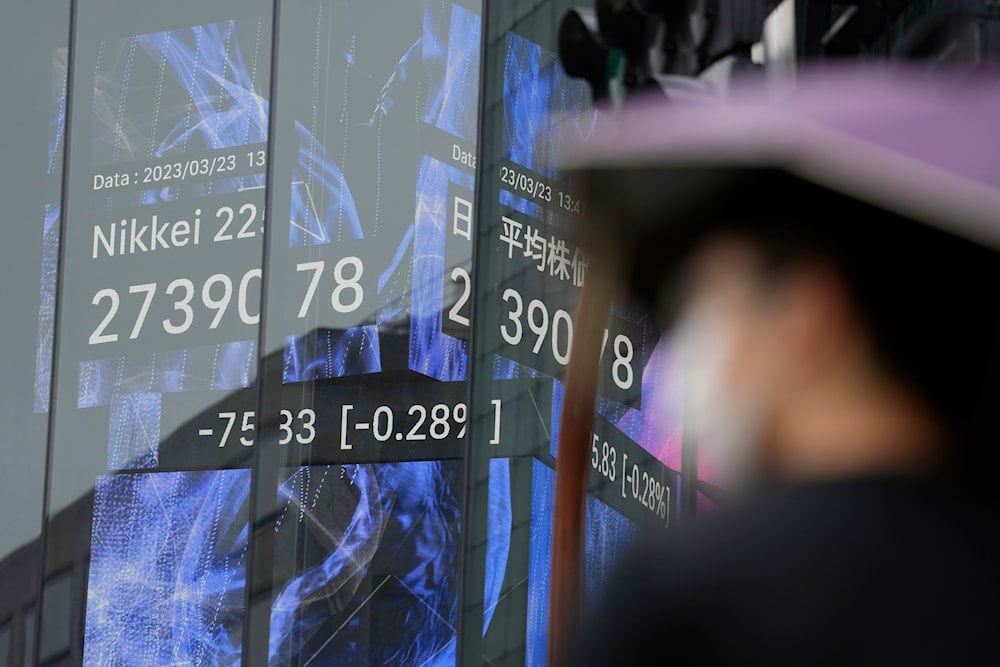Japan’s GDP shrinks in Q3 amid export slump and US tariffs
Japan’s economy contracted by 1.8% in Q3 2025, driven by falling exports and tighter regulations.
-

A person stands in front of an electronic stock board showing Japan's Nikkei 225 index at a securities firm in the rain on March 23, 2023, in Tokyo. (AP)
Japan's economy contracted by 1.8% in the July–September period, marking the first decline in six quarters. Government data released Monday attributed the contraction to a sharp drop in exports, particularly from automakers, as the effects of new US tariffs took hold.
The contraction, while significant, was less severe than economists had anticipated. Analysts suggested the decline reflects temporary factors rather than the beginning of a recession. "The contraction is largely due to one-time factors such as housing investment," said Kazutaka Maeda of the Meiji Yasuda Research Institute. He added that while exports also fell, "the trend still points to a gradual recovery over the next year or two."
Gross domestic product fell 1.8% on an annualized basis in the third quarter, compared to a revised 2.3% growth in the previous quarter. The latest figure was better than the 2.5% contraction forecast by economists in a Reuters poll. Quarterly, the economy shrank 0.4%, versus the median estimate of a 0.6% drop.
Automakers absorb tariffs with price cuts
Exports were the primary drag on growth as the impact of US tariffs deepened. Automakers, who had previously accelerated shipments ahead of the trade measures, saw volumes plummet. While they largely absorbed the tariffs through price reductions, the loss in export value affected overall economic performance.
Net external demand, which subtracts imports from exports, reduced GDP by 0.2 percentage points, reversing its 0.2-point positive contribution in the previous quarter. A formal US-Japan trade agreement implemented in September introduced a 15% tariff on nearly all Japanese imports, replacing an earlier rate of 27.5% for autos and 25% for other goods.
Domestically, the economy showed mixed signals. Housing investment slowed due to tighter energy-efficiency regulations introduced in April. However, private consumption, which accounts for more than half of Japan’s economic activity, rose 0.1%, aligning with market expectations despite high food costs dampening spending.
Capital expenditure grew by 1.0%, significantly outperforming the 0.3% forecast, signaling continued investment confidence among businesses. "Private consumption rose for the sixth straight quarter, and capital expenditure increased for the fourth consecutive quarter," said Economic Revitalization Minister Minoru Kiuchi. "This reinforces our view that the economy remains on a moderate recovery path."
Stimulus package and BOJ policy under spotlight
The weaker-than-expected GDP figures arrive as Prime Minister Sanae Takaichi’s government prepares an economic stimulus package aimed at easing household burdens amid rising living costs. Finance Minister Satsuki Katayama indicated the package would exceed 17 trillion yen ($109.94 billion), according to media reports.
Takuji Aida, chief Japan economist at Credit Agricole and a member of Takaichi’s economic panel, cautioned against a potential interest rate hike. "Given the contraction, it would be misguided for the BOJ to decide to raise interest rates in December," he noted in a client report.
Despite the contraction, a poll conducted by the Japan Center for Economic Research among 37 economists projected a rebound in the October–December quarter, with an expected growth of 0.6%. "From late this winter through around spring, there will be measures that improve households' income conditions in real terms," said Nomura Securities economist Uichiro Nozaki, adding, "Therefore, in terms of underpinning consumption in the first half of next year, this is a positive factor."

 4 Min Read
4 Min Read










